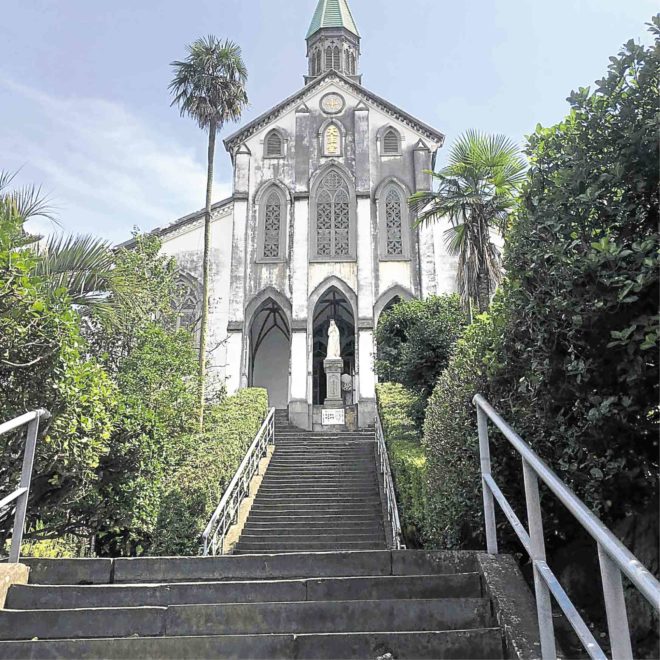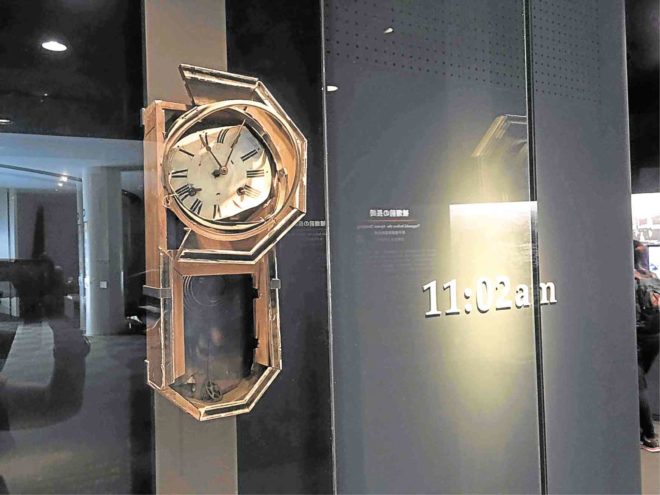
It’s a story of true, persistent faith. In 1865, after years of closure to the outside world, during which Japanese Christians (originally known as “kirishitan”) were persecuted and killed, Japan started reopening itself again.
Oura Cathedral had just been built by French missionaries in Nagasaki, in honor of the first 26 martyrs of the faith who were executed in 1587.
By his written account, one afternoon, Fr. Bernard Petitjean was visited by 15 men, women and children. These were “Hidden Christians” from nearby Urakami, who had secretly kept their faith going. The place had had over 250 years of isolation.
Our Lady of Japan
Approaching the priest, a woman placed a hand on her chest and told Petitjean in a whisper, “Our hearts are the same as yours.”
It is a story that takes on added poignancy inside the Cathedral, which stands atop a flight of stairs, a serene, white statue of the Virgin Mary, christened Our Lady of Japan, standing in welcome at the door.

It overlooks modern-day Nagasaki’s busy international port—there’s a massive cruise ship docked, visible from the historic Glover Garden—and features darkened wood interiors, stained glass windows, and a painting of the crucifixion of the 26 martyrs on one side of the altar.
In a park below, a small Japanese garden with a bust of St. John Paul II commemorates the first ever visit of a Catholic leader to Nagasaki, in 1981.
It may, indeed, be a modest church, but it was built by a people who had to fight for what they believed in, even at the risk of losing their lives.
Nagasaki may not be some Filipinos’ idea of a pilgrimage site in the same vein as Fatima, Lourdes or Jerusalem, but its importance was recently highlighted in pop culture in the Martin Scorsese movie “Silence.”
There’s a Kyushu Tourism booth at the 3rd Japan Travel Festival, Oct. 7-8, 10 a.m.-8 p.m., SM Mall of Asia.

Atomic bomb
Years later, many of the churches that rose would be leveled by another persecutor, the atomic bomb, dropped here by the Americans on Aug. 9, 1945 (serendipitously, it turns out, but more on that later).
Yet, this hilly place on the island of Kyushu has not just risen from the literal ashes; it is now also a progressive city full of sunshine and gardens, embraced by the ocean and very much preoccupied with promoting peace.
The pace is slower than large metropolises like Tokyo and Osaka, the people are friendly, and they take their time.
Christianity was introduced to Japan by the Jesuit priest Francis Xavier in 1549, and it flourished for almost 40 years. The Arima Christian Heritage Museum is partly a tribute to the most distinguished alumni of a seminary built there. Four teenage boys, known as the Tensho Embassy, were sent to Rome on an educational mission, and brought back a printing press used to produce books.
They came home to terrible times, however. Japan’s most powerful feudal lord of the time, Toyotomi Hideyoshi expelled the Jesuits. In 1597, he had 20 lay people and six missionaries executed.
The 26 Martyrs Museum and Monument, built in 1962 in Nagasaki’s Nishizaka Park, is a gem of a history trove, with such interesting artefacts as crucifixes and icons made by the hidden Christians.
There are small metal plates showing religious figures—the Virgin Mary, Jesus on the Cross—that people were forced to trample on to prove they weren’t Christians. Those who refused were executed, most horribly by being thrown into the nearby “Unzen Hell,” a natural hot spring with scalding water. In the spring, amid the steam rising from the still flowing waters, a cross marks the spot where the faithful were boiled to death.
Also in the museum is a small icon of the Lady of the Snows, a 17th-century Japanese painting, graciously lent to the production crew for an important scene in “Silence” that showed the hidden Christians at worship.
Outside the museum, a familiar figure: a statue of St. Lorenzo Ruiz, the first Filipino saint, who was martyred in Nagasaki in 1637 in the wave of executions following that of the original 26.
A photograph of the late Jaime Cardinal Sin presenting the statue to the Japanese people in October 1992 stands behind the image. As the museum’s curator enthused, “We are grateful to the Philippines. If not for Lorenzo Ruiz, the Pope might not have visited us!”
The dramatic martyrs’ monument, meanwhile, was crafted in bronze by sculptor Funakoshi Yasutake, a phalanx of life-size likenesses with the distinct heights and facial features of each individual.
Rebellion
Another interesting stop on a pilgrimage is a visit to the ruins of Hara Castle in Minamishimabara City. Sick and tired of religious oppression, the peasants of Arima and Amakusa took up arms in December 1637 in what has been called the Shimabara Rebellion, led by an unlikely hero, a pious, charismatic 16-year-old named Amakusa Shiro.
Shiro’s legend naturally spread, with tales of him walking on water and bringing a bible wherever he went. The rebels died after barricading themselves at Hara Castle for 88 days. Shiro’s head was even put on gory display.
Today, there’s not much to see at the site, other than ancient stones and a monument to Shiro.
Archaeological excavations, however, have revealed not just grim evidence of a massacre—scarred, broken human bones—but medals, crucifixes and other items that must have kept the rebels steadfast in their final hours.

Second atomic bomb
Not too many people know that Nagasaki was not the original choice for the second atomic bomb—the plane was headed to a different city, Kokura.
Instead, miscalculations and unfavorable wind conditions sent Fat Man hurtling down on Nagasaki, where as many as 75,000 people were believed to have been killed immediately, changing the city’s fate forever.
In the sparse, sunlit Nagasaki Atomic Bomb Museum, a clock that stopped exactly at 11:02 a.m., when the bomb struck, is one of the first things a visitor sees.

There are simulated ruins of the Urakami Cathedral, and a frightening replica of an atomic bomb hanging over visitors’ heads like a warning. Electronic exhibits recounting the waves of atomic death are juxtaposed beautifully against gut-wrenching accounts, poems, photographs and reports of survivors who watched their loved ones writhe in agony before their eyes, skin peeling off their bodies.
“Please do not forget,” reads a message on a wall. “Please tell others.”
And then, as one leaves the museum, hovering above the bomb are what look like ethereal silver birds, symbols of peace.
Probably the most powerful image from the bombing was found amid the ruins of the Urakami Cathedral. A priest searching the rubble found a charred wooden face of the Virgin Mary, what used to be the head of the statue of the Immaculate Conception that stood at the main altar.
The priest kept the head, and returned it to the reconstructed church 30 years later, where it was enshrined in a special chapel as Hibaku no Maria (“atomic-bombed Mary”).
The relic would later accompany the Archbishop of Nagasaki on peace pilgrimages, and would even make an appearance in the United Nations in New York, at the signing of the Treaty on the Non-Proliferation of Nuclear Weapons, on July 1, 1968.
There could have been no better symbol of the urgent need to end war—and of how faith can survive any disaster.
Visit www.japan-tour.jp/en, www.facebook.com/japan.kyushu.discovery/; follow japan_discovery @Instagram. Visit the Kyushu Tourism booth at the 3rd Japan Travel Festival, Oct. 7-8, 10 a.m.-8 p.m., at SM Mall of Asia.









































